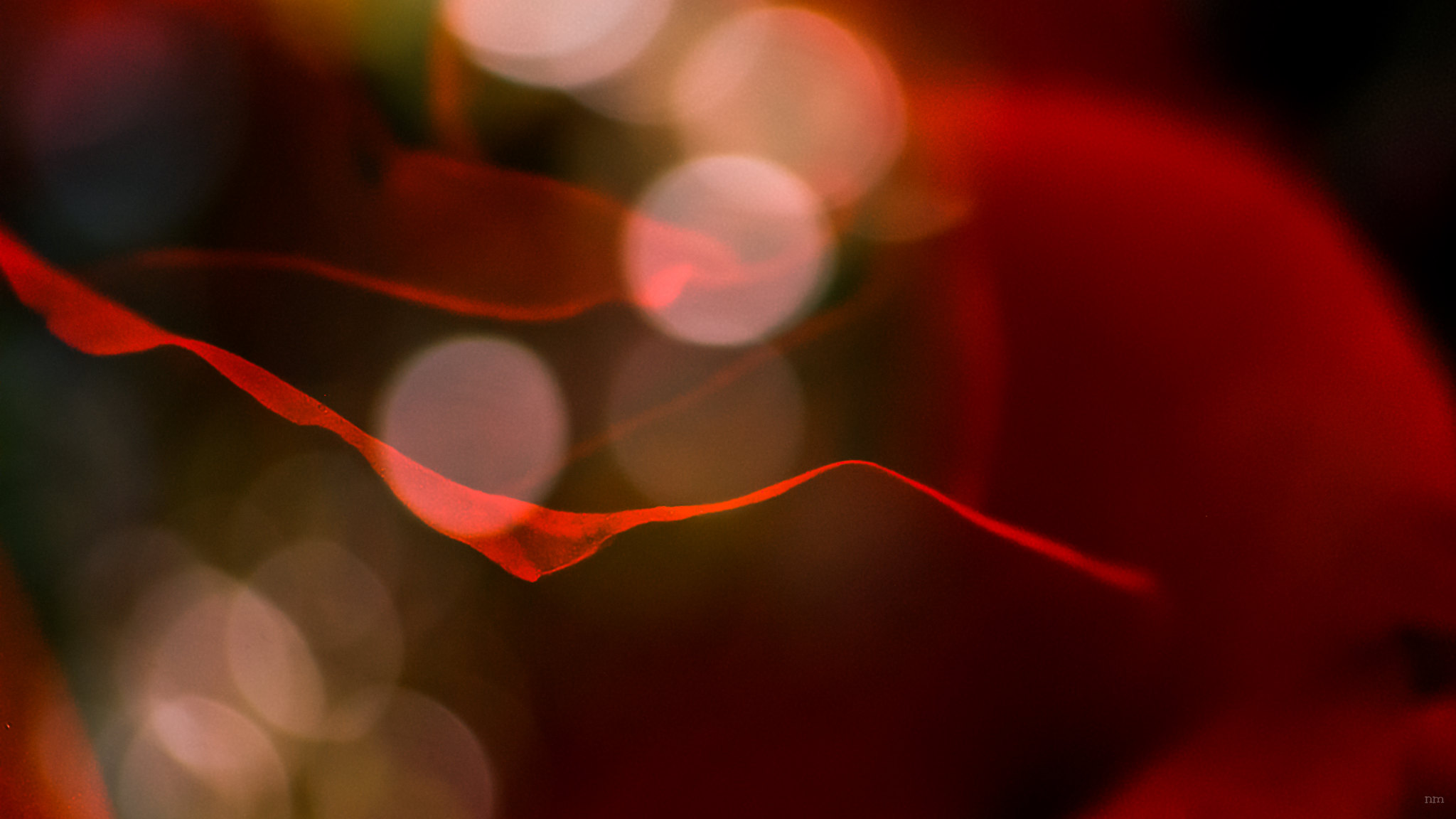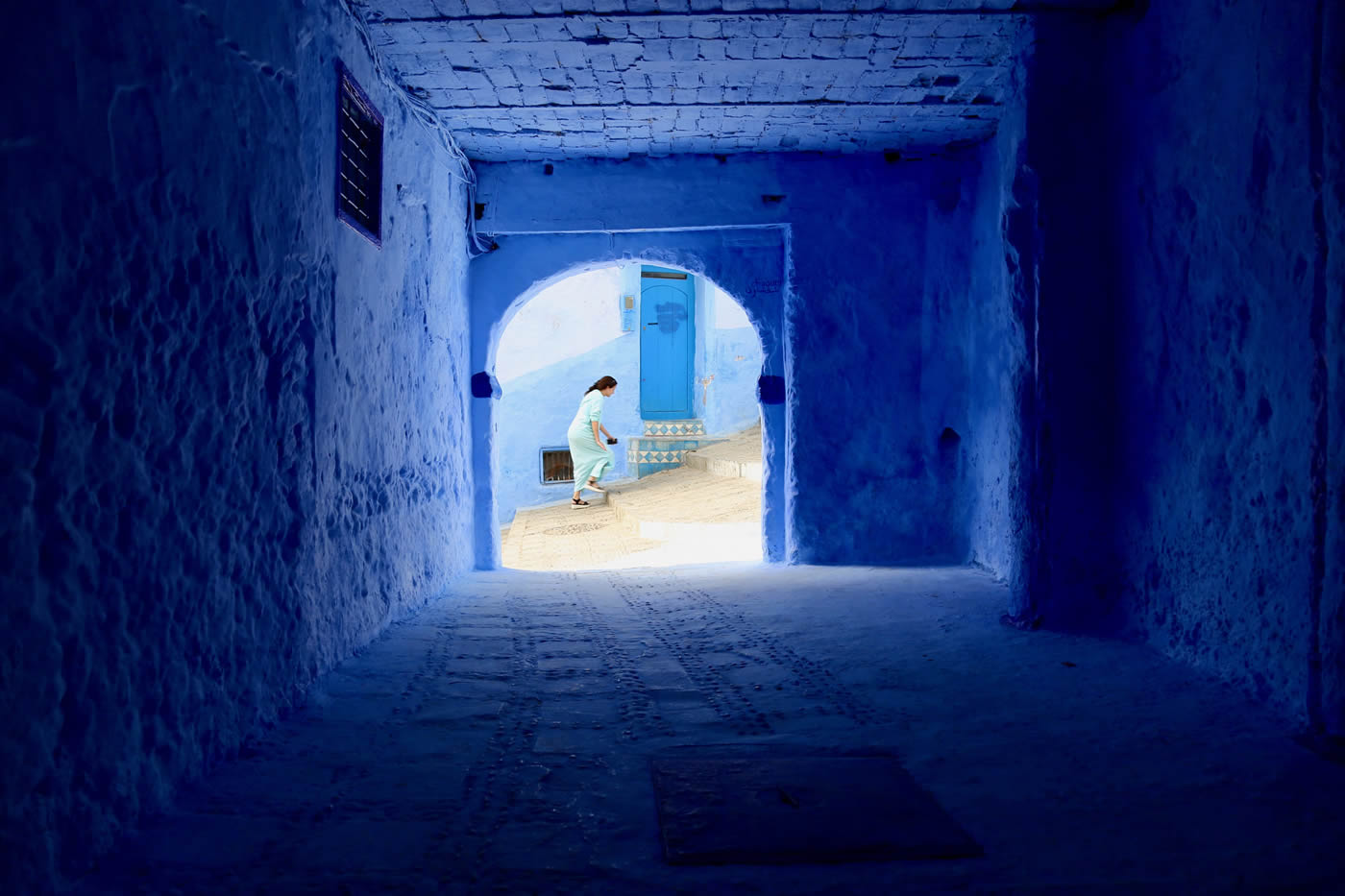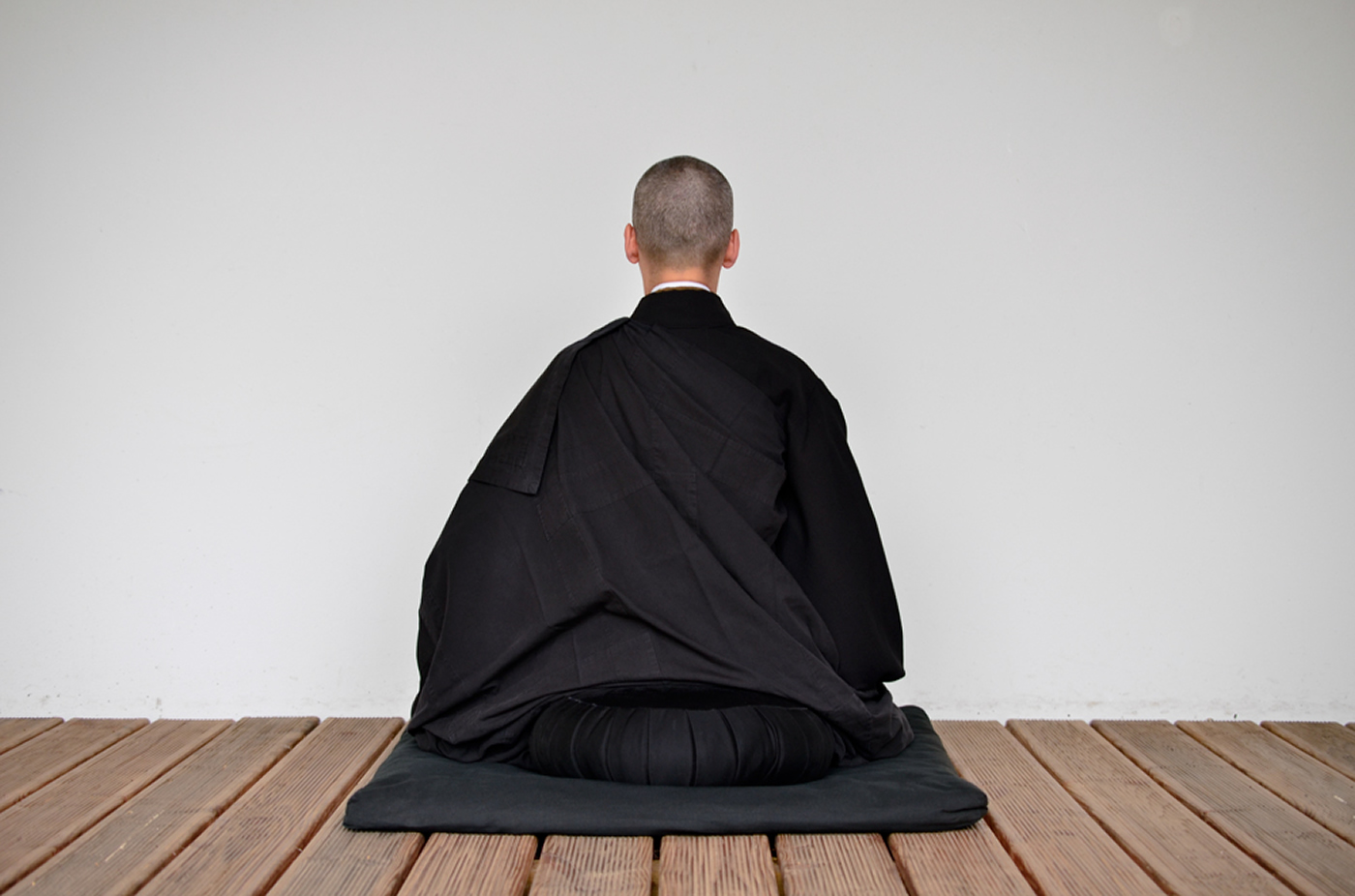Class 21: Seeing that the Jail is a Jail
[su_icon icon=”icon: link” color=”#ff1259″ size=”20″ shape_size=”12″ url=”https://youtu.be/9sftC_mVhx0?t=6s” target=”blank”]Video[/su_icon]Hi, welcome back to the Wheel of Life at-home retreat. And I’d like to thank Stanley again for translating, thanks for staying in America and translating. We’re on Session 21. It’s called “Seeing that the Jail is a Jail.” And the picture is a jail. We actually used to have a very active program of teaching lam rim (LAM RIM) in the jails. And it helped the prisoners a lot, and the government thanked us because the prisoners got in less fights. The picture you see here is kind of perfect for a jail because it’s really depressing in a jail.
So when we study the Wheel of Life in the monastery, we study it from a set of books called sur kol (ZUR BKOL). And it’s a tradition to take about five different subjects, and you squeeze special subjects out of bigger books, like the way you would squeeze medicine out of an herb. And for our computer project, saving the ancient books, that was actually the first book we ever printed and was called sur kol—the five books that are extracted from the big books. And you’ll be interested to know that the whole Wheel of Life teaching as it is taught in the monastery and we study it for about 2-3 months, It all comes from one line from Maitreya.
I should say one verse, not one line. And I think you’ve heard me say this line before:
de ne sengge nam gyingpay
ting-nge-dzin la nyom shuk ne
ten ching drel jung luk tun dang
luk mi tun la tokpay che
(DE NAS SENG GE RNAM BSGYINGS PA’I,
,TING NGE ‘DZIN LA SNYOMS ZHUGS NAS,
,RTEN CING ‘BREL ‘BYUNG LUGS MTHUN DANG,
,LUGS MI MTHUN LA RTOG PAR BYED,)
It teaches both the Lion’s Dance and the Wheel of Life. And the part that I want to talk about today is the ending part. It says ten ching drel jung luk tun dang luk mi tun (RTEN CING ‘BREL ‘BYUNG LUGS MTHUN DANG LUGS MI MTHUN). luk tun dang luk mi tun (LUGS MTHUN DANG LUGS MI MTHUN)—luk tun (LUGS MTHUN) means one triggers two, two triggers three, three triggers four, etc. The wife in the kitchen says, “I didn’t do anything—he yelled at me!” So that’s link number one. Then she yells back. That’s luk tun which means “normal order.” Then luk mi tun (LUGS MI MTHUN), which is sometimes called luk dok (LUGS LDOG)—it means “to turn (the wheel) backwards,” to shut down the wheel.
[su_icon icon=”icon: link” color=”#ff1259″ size=”20″ shape_size=”12″ url=”https://youtu.be/9sftC_mVhx0?t=4m29s” target=”blank”]Video[/su_icon]So, you kind of think, “Oh, it must be since it says backwards, it must go from twelve, to eleven, to ten. First I die, then I get old, then I get born, then my karma gets fat, then I arm the karma.” I mean you could have some strange ideas like that. But here in the lam rim, they describe what it really means to turn the wheel around. de dak luk dok tu gog nupay lam shik nyam su len na (DE DAG LUGS LDOG TU ‘GOG NUS PA’I LAM ZHIG NYAMS SU LEN NA)—so we are following the Tibetan—de dak luk dok tu gog nupay lam shik nyam su len na, if you undertake a path which will enable you to stop the wheel of life by reversing it.
if you stop misunderstanding, then you stop making karma. Let’s take it to the kitchen, which is where you should take all your Dharma. If you can’t take it to the kitchen, it’s not Dharma.
So, what does it mean to reverse the wheel of life, to shut down the wheel of life? marikpa gakpe duje gak (MA RIG PA ‘GAG PAS ‘DU BYED ‘GAGS)—if you stop misunderstanding, then you stop making karma. Let’s take it to the kitchen, which is where you should take all your Dharma. If you can’t take it to the kitchen, it’s not Dharma. Okay, and what, if it is Dharma, then you should be able to take it to the kitchen. Something like that. There shouldn’t be anything in the 300,000 books of Buddhism that we have that you cannot find in the kitchen. And if something good or bad is happening in the kitchen, it must be described in the ancient books. Because the ancient books were written for the kitchen.
marikpa gakpe duje gak means if she can stop having misunderstanding about her husband, if she doesn’t say, “I don’t know why he yelled at me,” She says, “Ah, I know why he yelled at me! I was yelling at my kids last week.” She just reversed the first link. She just blocked the first link. If you block that “I didn’t do anything,” then automatically, you will not reach the second link—”I am not stupid; you are stupid!” Okay good. So if you stop the first link, then the second link will never come. So that’s how we stop the Wheel of Life.
[su_icon icon=”icon: link” color=”#ff1259″ size=”20″ shape_size=”12″ url=”https://youtu.be/9sftC_mVhx0?t=8m04s” target=”blank”]Video[/su_icon]Don’t forget Wheel of Life is a kind of a bad name, misnomer. It’s not really the Wheel of Life. I mean, a Buddha also has life. It means the wheel of bad life and painful life. marikpa gakpe duje gakpa ne (MA RIG PA ‘GAG PAS ‘DU BYED ‘GAGS PA NAS)—if you stop link number one, you stop link number two. Eventually, you’ll stop everything up to getting old and dying. dukgnel tamche gakpar gyur ro (SDUG BSNGAL THAMS CAD ‘GAG PAR ‘GYUR RO)—all the pain in your life will be stopped. Also don’t think Wheel of Life means if you get out of the Wheel of Life you have to die or disappear. In the Wheel of Life, for example, in the painting, the Buddha is outside the wheel and he’s pointing to the moon, which represents Nirvana. Ok, let’s go back to the text.
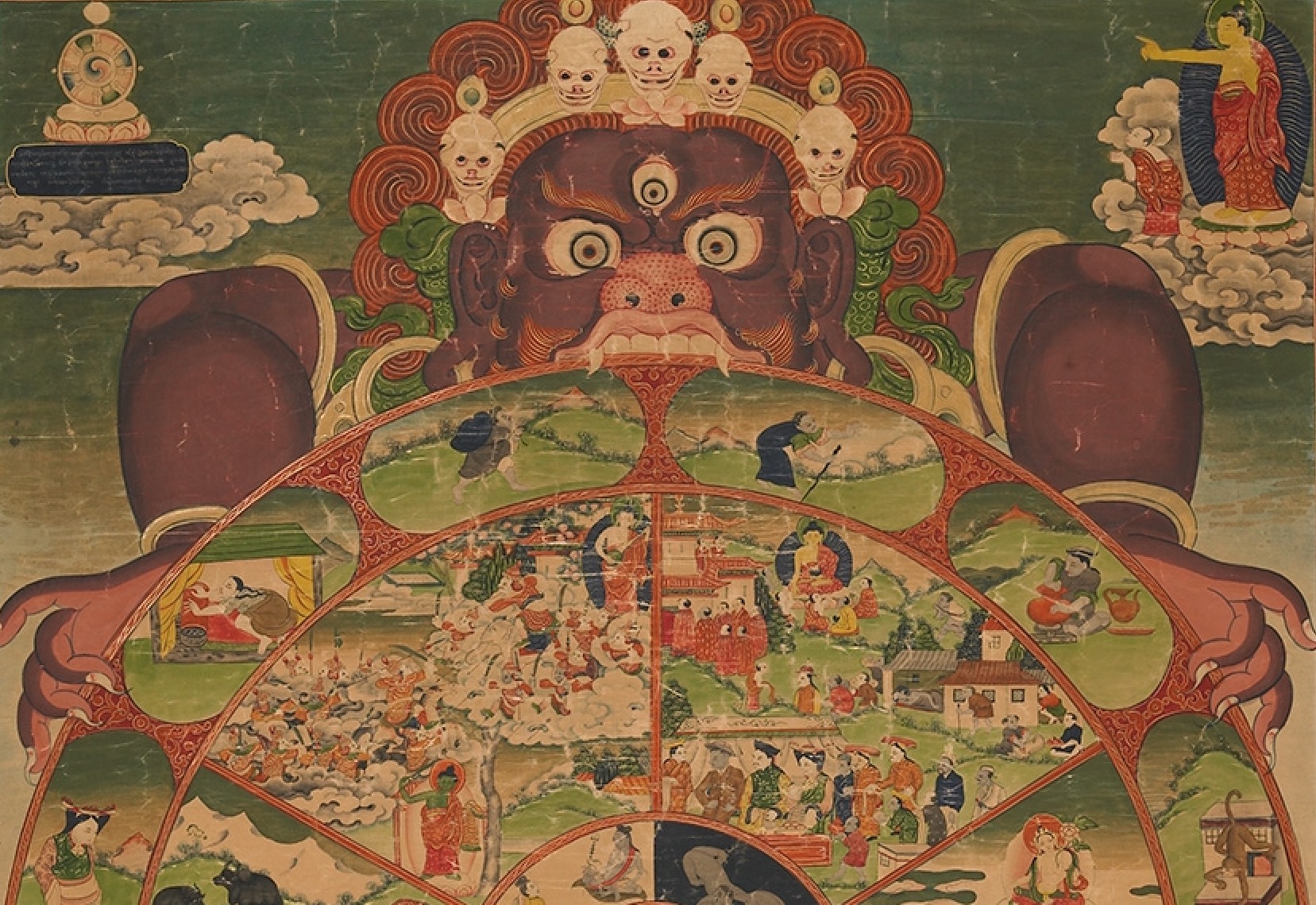
dor du na, tendrel yenlak chu nyi le dang nyonmong dukngel gyi tendrel sum dundu te (MDOR BSDU NA, RTEN ‘BREL YAN LAG BCU GNYIS LAS DANG NYON MONGS SDUG BSNGAL GYI RTEN ‘BREL GSUM DU ‘DU STE). dor du na (MDOR BSDU NA) means “let’s kind of summarize everything.” You can take all twelve links, and just for summary, we can divide them differently than many ways we divided them before. We can divide them into (1) karma, (2) negative thoughts, and (3) pain. Okay, you can divide into those three.
marikpa dang sepa lenpa sun nyonmong (MA RIG PA DANG, SRED PA, LEN PA GSUM NYON MONGS)—three of the links are negative emotions. That’s misunderstanding your husband. And then sepa (SRED PA) we’ve been saying like negative coffee meditation. “Are you sorry that you yelled at your husband?” “No.” Then lenpa (LEN PA) is like advanced negative coffee meditation. “I don’t believe there’s any connection between yelling at my kids and my husband yelling at me.” So those three are all negative thoughts.
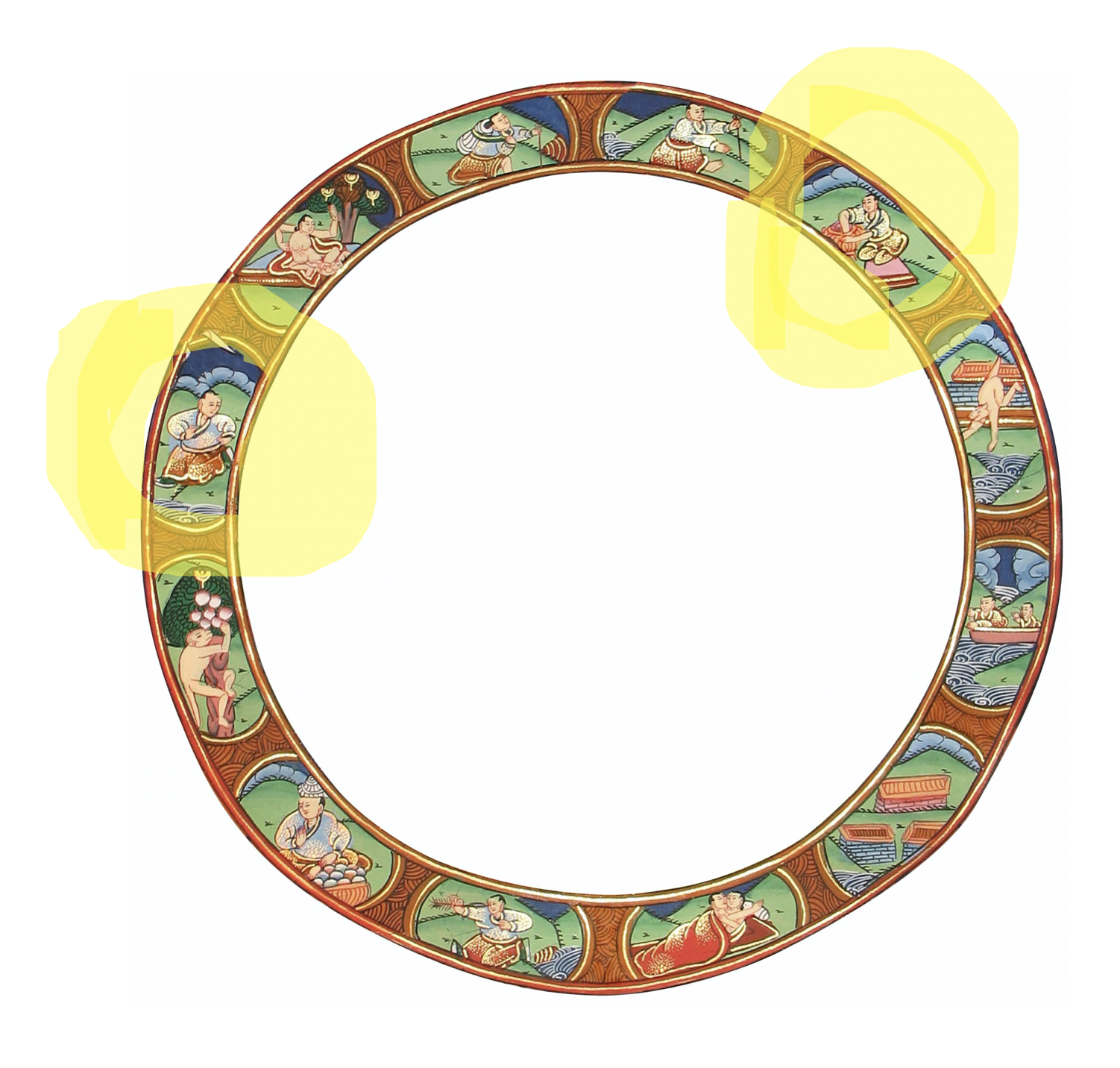
duje dang sipa nyi le dang (‘DU BYED DANG SRID PA GNYIS LAS DANG)—link number two and link number ten, those two are karma but different stages of karma. Number two is? (fresh karma) Yeah, like watermelon (just planted) Yeah. And #10 is? [ripened karma, seeds are fat and ready] Yeah good, so translate that while I drink my coffee. Then he says a strange thing. hlakma dun dukngel (LHAG MA BDUN SDUG BSNGAL)—and the other seven, they are suffering. And then he quotes Ludrup (KLU SGRUB), Arya Nagarjuna. And this happens to be the same text about the essence of dependent origination that we had before. It’s very short. It’s like one or two pages. So, let’s follow the Tibetan, because there’s going to be two interesting points here.
[su_icon icon=”icon: link” color=”#ff1259″ size=”20″ shape_size=”12″ url=”https://youtu.be/9sftC_mVhx0?t=12m41s” target=”blank”]Video[/su_icon]dangpo gyepa gu nyonmong (DANG PO BRGYAD PA DGU NYON MONGS)—”the first one, the eighth one, and the nine are negative thoughts.” The first one, the eighth, and nine. You see he (Nagarjuna) doesn’t say “ninth.” He says “the nine”. Why didn’t he say ninth and he just said nine? Because it’s poetry and he didn’t have room to put “TH.” So don’t get confused. You should hear pa (PA)—gupa (DGU PA). Okay, so now it’s clear: number one, number eight, and number nine, these three are negative emotions.
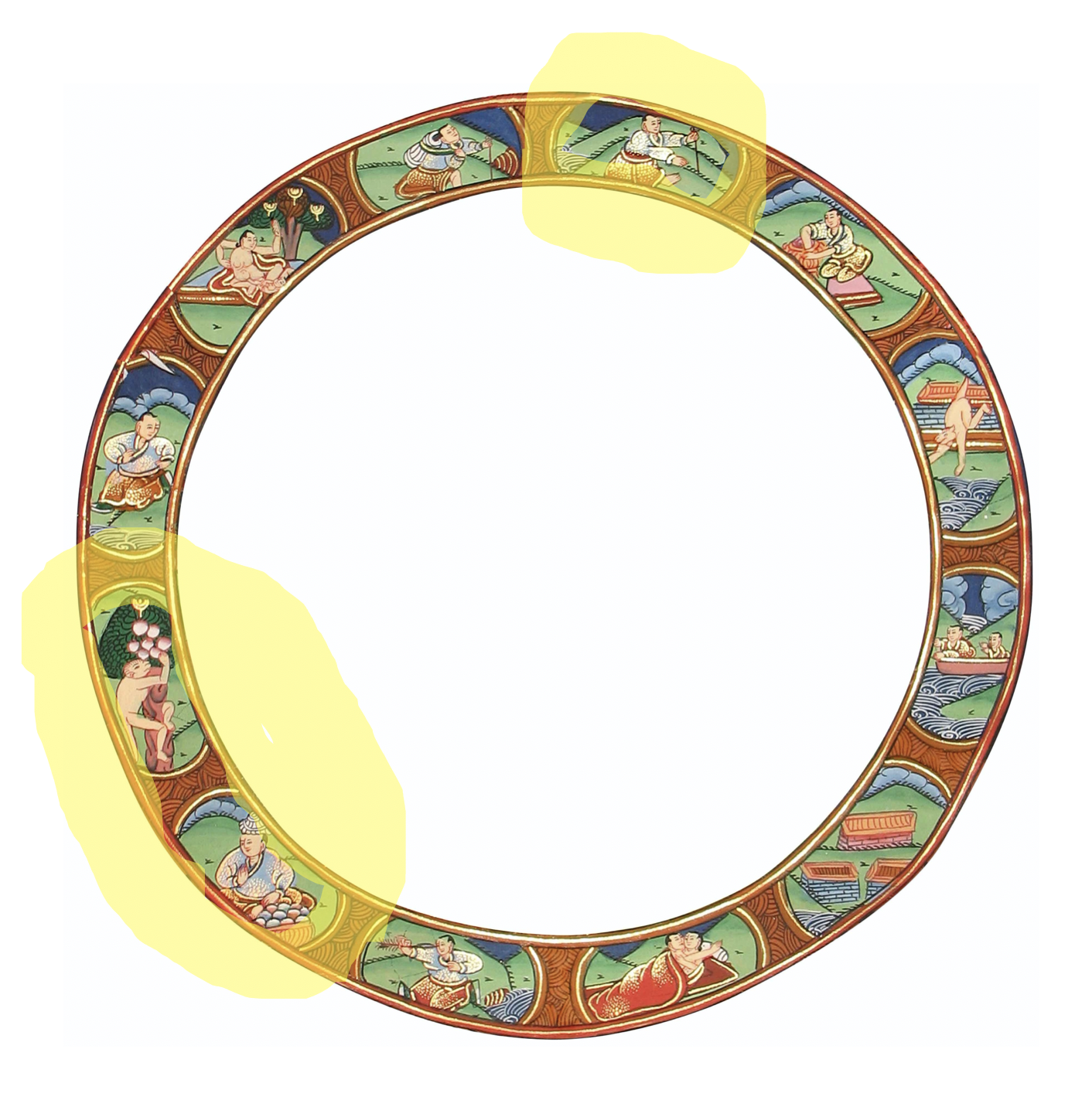
nyipa chupa le yin te (GNYIS PA BCU PA LAS YIN TE)—”number two and number ten, (these) are the (two) karmas.” These two are karmas. hlakma dun ni (LHAG MA BDUN NI)—now the rest of the seven—”the remaining seven”—dukngel yin (SDUG BSNGAL YIN)—these “are suffering.” Now I always like to go to the original text any time, this is a Mixed Nuts rule. Any time there’s a quotation in a book, the rule of our Mixed Nuts translation team … we are all reincarnations of the students of Master Xuanzang in the Wild Goose Pagoda Tower during the Tangchao.
We have a rule: if there’s a quotation, go check it and make sure it’s correct. So I checked it, and then I said to myself it’s correct. Then I saw there’s one word different. The way it’s quoted in the lam rim, The last line says hlakma dun ni (LHAG MA BDUN NI)—means now the last, remaining seven, they are suffering. But that’s a little uncomfortable, right? I mean the others must be suffering also—the whole wheel is suffering. The real ancient Tengyur (BSTAN ‘GYUR) version of this verse, it says hlakma dun yang (LHAG MA BDUN YANG), not ni (NI).
Okay here, look here—hlakma dun ni, and this says lhakma dun yang, which means, the remaining seven are “also” pain. So I think anyone who listened to this class so far, I can accept that three of those are negative emotions: number one, number eight, and number nine. I can understand that two of them are karma: number two and number ten. But why does he say and the remaining seven are suffering? Why does he say that, because aren’t those first five suffering also? And if you thought that when you heard me say it first, you’re correct.
[su_icon icon=”icon: link” color=”#ff1259″ size=”20″ shape_size=”12″ url=”https://youtu.be/9sftC_mVhx0?t=17m03s” target=”blank”]Video[/su_icon]Because the real verse says, “the remaining seven are also suffering.” So I made some … my very third-grade childlike drawings here. I put some color around the first, eighth, and ninth links, which are negative emotions. Then in the next image, I put some color around two and ten together. And then in the next image, I put colors around three to seven, and eleven to twelve—these seven. And of course by now, you know that these two groups are kind of the same thing. Three, four, five, six, seven, and 11 and 12, they’re almost the same thing. Why?
-
- Link three: my mind comes into my mom.
- Link four: my body and mind are inside my mom.
- Link five: my eyes, and ears, and nose, etc., grow inside my mom.
- Link six: they make contact with the outside world.
- Link seven: because of that contact, I get feelings—like good feelings or bad feelings.
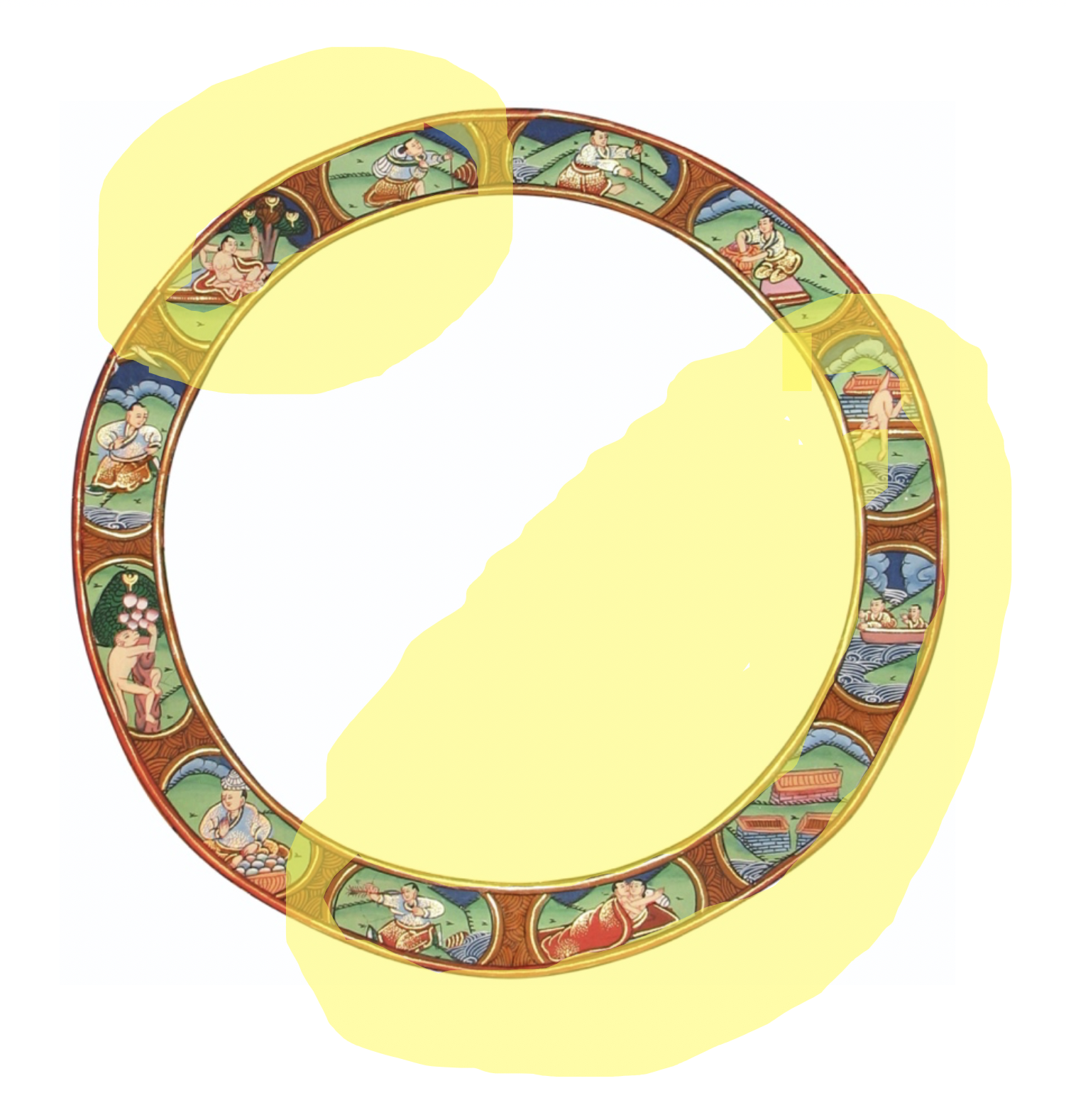
Three, four, five, six, seven—but they’re the same as eleven and twelve. Eleven and twelve together are one whole human life. I’m born, I get old, and I die. diy tsik kang dangpo (‘DI’I TSIG RKANG DANG PO)—so those are the three images I put up for you. diy tsik kang dangpoy de sum kun long dang (‘DI’I TSIG RKANG DANG PO’I DE GSUM KUN SLONG DANG). He said—interesting—you can think of the first line of the verse, okay, where Nagarjuna says the first, and the eighth, and the ninth, these are the negative emotions—you can think of those as being the process of motivation to do something bad.
Then you can think of the next line—the next line says number two and number ten are karma—If you think about it, number two and number ten, these are karma expressed by doing things or saying things. Where’s the mental karma? He already covered it, in the first group. The first group, those three mental afflictions are mental karma. Which means link number one is link number two. Number two, he says here, must refer to the things you say and the things you do because of your bad motivation. Why in number two—the potter—did he leave out karma of thinking? Because that was already in the misunderstanding. That’s karma of the mind. Okay.
[su_icon icon=”icon: link” color=”#ff1259″ size=”20″ shape_size=”12″ url=”https://youtu.be/9sftC_mVhx0?t=21m52s” target=”blank”]Video[/su_icon]tsik kang sumpay de nam longchu yin (TSIG RKANG GSUM PA’I DE RNAMS LONGS SPYOD YIN)—then in the third line here—which says the other seven are suffering—these links are just kind of what are the objects in your life that you experience. tendrel chu nyi luk jung dok tu sampay (RTEN ‘BREL BCU GNYIS LUGS ‘BYUNG LDOG TU BSAMS PA’I)—if you contemplate on these twelve links, how they happen in order and how you shut them down. korwa chiy dukngel gompe (‘KHOR BA SPYI’I SDUG BSNGAL BSGOMS PAS)—then really, you are automatically doing a meditation on the pain of life.
No matter how wealthy you are, no matter how young you are it doesn’t matter—you are still locked in the jail of death.
And then automatically there will be a shift in your heart. You will start to understand, “Oh my god, I’m like a prisoner in this wheel. This world is a prison. My life is a prison. My whole life I’ve been inside a prison. And I’m condemned in this prison. The only way I’d leave this prison is to die.” And it’s not a metaphor; it’s real. No matter how wealthy you are, no matter how young you are it doesn’t matter—you are still locked in the jail of death.
Then, number one, you’d be crazy to think that all the people before you died, but you’re not going to die. Then if someone told you, you know, there’s a pretty easy way to stop that problem, then I think you’d have to be crazy not to at least listen to them. So just the idea, “my life is like a prison no matter what happens in my life, good or bad, I will lose everything, even my life.” Then finally you get this idea, “Oh, maybe there’s a way I can get out. I mean, I don’t want to die, but I would like to change life and make it like a paradise. I would like to do that.”
[su_icon icon=”icon: link” color=”#ff1259″ size=”20″ shape_size=”12″ url=”https://youtu.be/9sftC_mVhx0?t=25m15s” target=”blank”]Video[/su_icon]Then he says ngejung yin (NGES ‘BYUNG YIN)—”that’s renunciation.” In English, the word renunciation … first of all, waiters in restaurants never used this word. Even in the ancient Christian tradition where the word came from, it means “I will stay in the monastery, I will eat simple food, I will have a simple bed,” like that. But the word in Buddhism, the original word ngejung (NGES ‘BYUNG), it has a different feeling and a different meaning. Of course, all of you who studied ACI courses, you know, this is the first of the three principal paths, and it’s very simple to explain it.
When you say “This guy is rich,” you just mean “This guy has more money in his prison cell, that’s the same cell that I’m in.”
It just means, “I want to get out!” It doesn’t mean what it means in the Christian word renunciation; it doesn’t mean that. It doesn’t mean “I will avoid fancy food” or “I won’t go on vacations” or “I won’t watch movies.” Buddhism ngejung means “I definitely want to get out of here.” So your life, from the time you’re born … from the minute you are born to the minute you die, the whole thing is exactly the same as a prison. When you say “This guy is rich,” you just mean “This guy has more money in his prison cell, that’s the same cell that I’m in.” Or “this movie star is very beautiful,” but it just means she’s in the same prison cell that I’m in and she’s going to lose all her beauty also.”
I don’t see this word renunciation meaning “grumpy ordained person.” In many religious traditions, including Buddhism, renunciation, the picture in your mind, is like a monk or nun who is sort of unhappy. They’re not going to eat doughnuts because they taste good. You don’t think of someone joyful. But what we talked about today, if you get real renunciation, it’s sort of like Steve Jobs or something. It means you’re very excited about a new idea, that’s all. It’s like a new vision … what’s that guy’s name, Elon Musk, Yeah, “Let’s make a new rocket ship,” “Let’s make a new kind of car,” and renunciation should be like that. Yeah, that’s “Let’s get out of this sucky world—let’s do a cool world. Yeah, we could that.”
[su_icon icon=”icon: link” color=”#ff1259″ size=”20″ shape_size=”12″ url=”https://youtu.be/9sftC_mVhx0?t=29m48s” target=”blank”]Video[/su_icon]Okay, so it’s kind of like, I don’t know … Elon Musk doesn’t want to ride around in a car that’s polluting the whole planet, he has like a positive happy, cool vision. Yeah, “Let’s get rid of the stinky cars, everyone get a Tesla, and then the whole world is clean.” That’s that’s how renunciation should taste. I want a cool world, I don’t want this stupid world. Get old, wrinkled like an old monkey, then no teeth, then die, you know. That’s not cool. I want something cool!
Okay, so get that feeling about renunciation. I don’t know, you can probably feel, the lamrim here is shifting from explaining the problem. And you could feel sort of this Elon Musk thing, “Oh, we have a solution coming.”
And let’s get on to the solution in the next video.
See you then.

